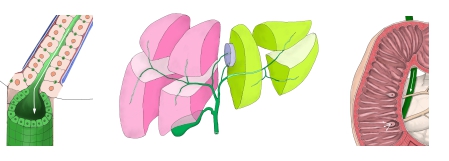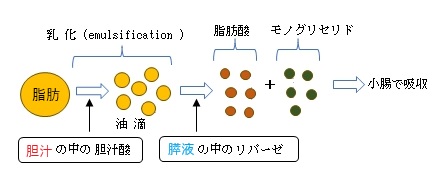【概 要】



【より詳細な図】
以下は胆汁の産生から排出までを簡単に表した図となる。



胆汁酸 : 脂肪を乳化して消化酵素の働きを補助、
胆汁色素 : ビリルビン(赤血球のヘモグロビン由来のヘムの代謝物)由来
・胆汁には消化酵素は含まれていない。
【胆汁の働き】
1. 脂肪の消化促進
・胆汁に含まれる胆汁酸塩は脂肪の塊を小さな油滴にまで分解する。
・油滴にまで分解された脂肪は膵液中の酵素(リパーゼ)によって脂肪酸とモノグリセリドに分解され小腸からの消化を促進させる。

2. 老廃物の排出
胆汁は肝臓での代謝・解毒作用によって生成された脂溶性の老廃物(ビリルビン、薬物代謝産物など)を十二指腸経由で便と共に体外へ排出。
注意)水溶性の老廃物(尿素、クレアチニンなど)は血流によって腎臓に運ばれ尿として体外へ排出。

【その他】
腸肝循環:enterohepatic circulation、胆汁成分(主に胆汁酸)が小腸から再吸収されて、肝臓に戻り、再び胆汁として使われる循環
【Wikipedia】
Bile (from Latin bilis), also known as gall, is a yellow-green/misty green fluid produced by the liver of most vertebrates that aids the digestion of lipids in the small intestine. In humans, bile is primarily composed of water, is produced continuously by the liver, and is stored and concentrated in the gallbladder. After a human eats, this stored bile is discharged into the first section of the small intestine, known as the duodenum.[1]
Composition
[edit]
In the human liver, bile is composed of 97–98% water, 0.7% bile salts, 0.2% bilirubin, 0.51% fats (cholesterol, fatty acids, and lecithin), and 200 meq/L inorganic salts.[2][3]
The two main pigments of bile are bilirubin, which is orange-yellow, and its oxidised form biliverdin, which is green. When mixed, they are responsible for the brown color of feces.[4] About 400 to 800 milliliters (14 to 27 U.S. fluid ounces) of bile is produced per day in adult human beings.[5]
Function
[edit]
Bile or gall acts to some extent as a surfactant, helping to emulsify the lipids in food. Bile salt anions are hydrophilic on one side and hydrophobic on the other side; consequently, they tend to aggregate around droplets of lipids (triglycerides and phospholipids) to form micelles, with the hydrophobic sides towards the fat and hydrophilic sides facing outwards.[6] The hydrophilic sides are negatively charged, and this charge prevents fat droplets coated with bile from re-aggregating into larger fat particles. Ordinarily, the micelles in the duodenum have a diameter around 1–50 μm in humans.[7]
The dispersion of food fat into micelles provides a greatly increased surface area for the action of the enzyme pancreatic lipase, which digests the triglycerides, and is able to reach the fatty core through gaps between the bile salts.[8] A triglyceride is broken down into two fatty acids and a monoglyceride, which are absorbed by the villi on the intestine walls. After being transferred across the intestinal membrane, the fatty acids reform into triglycerides (re-esterified), before being absorbed into the lymphatic system through lacteals. Without bile salts, most of the lipids in food would be excreted in feces, undigested.[9]
Since bile increases the absorption of fats, it is an important part of the absorption of the fat-soluble substances,[10] such as the vitamins A, D, E, and K.[11]
Besides its digestive function, bile serves also as the route of excretion for bilirubin, a byproduct of red blood cells recycled by the liver. Bilirubin derives from hemoglobin by glucuronidation.
Bile tends to be alkaline on average. The pH of common duct bile (7.50 to 8.05) is higher than that of the corresponding gallbladder bile (6.80 to 7.65). Bile in the gallbladder becomes more acidic the longer a person goes without eating, though resting slows this fall in pH.[12] As an alkali, it also has the function of neutralizing excess stomach acid before it enters the duodenum, the first section of the small intestine. Bile salts also act as bactericides, destroying many of the microbes that may be present in the food.[13]